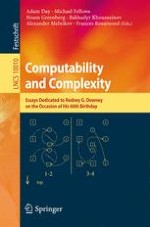This Festschrift is published in honor of Rodney G. Downey, eminent logician and computer scientist, surfer and Scottish country dancer, on the occasion of his 60th birthday.
The Festschrift contains papers and laudations that showcase the broad and important scientific, leadership and mentoring contributions made by Rod during his distinguished career. The volume contains 42 papers presenting original unpublished research, or expository and survey results in Turing degrees, computably enumerable sets, computable algebra, computable model theory, algorithmic randomness, reverse mathematics, and parameterized complexity, all areas in which Rod Downey has had significant interests and influence. The volume contains several surveys that make the various areas accessible to non-specialists while also including some proofs that illustrate the flavor of the fields.
